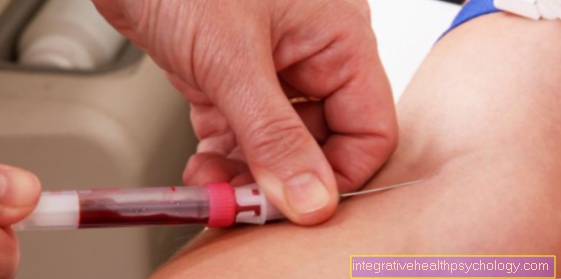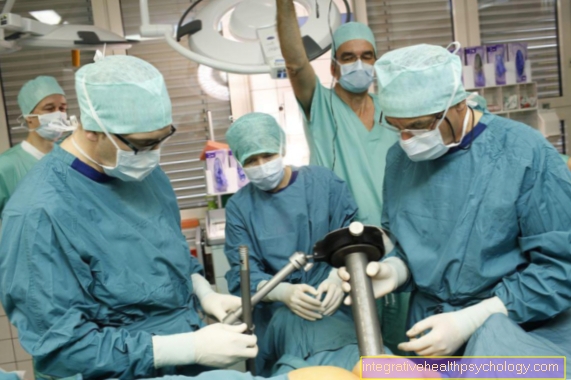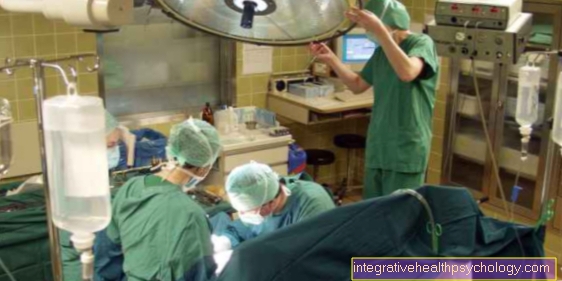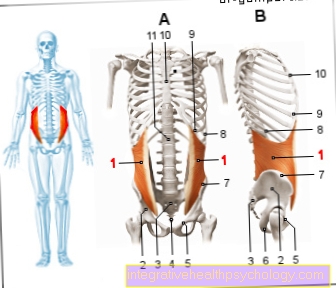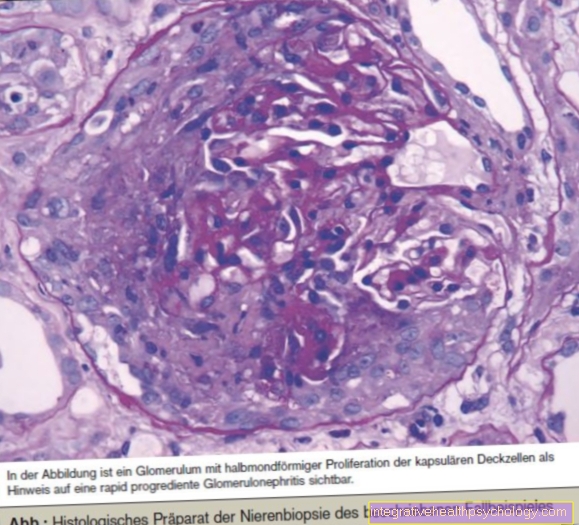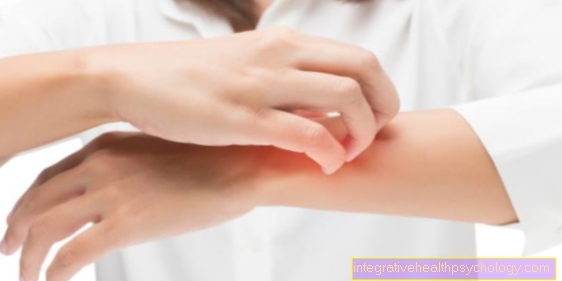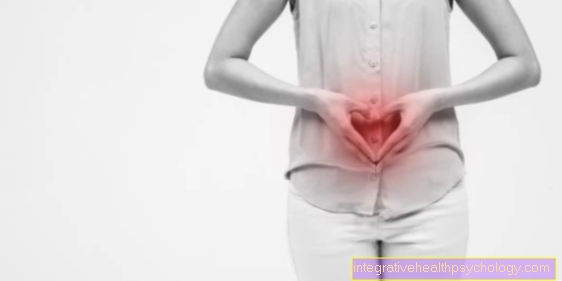Pain in the left costal arch
General
The costal arch is a cartilaginous structure that connects the lower ribs to the sternum.
This can lead to unilateral or bilateral pain due to trauma, organ diseases or other causes.

Causes of left rib pain
Common causes:
In most cases, the causes of costal pain are harmless. An organic disease is rarely the cause.
Trauma that occurs during exercise, for example, is a common cause of this pain. This can lead to bruises in the area of the ribs, torn muscle fibers between the ribs or, in particularly severe cases, even to broken ribs.
Herpes zoster, a viral infection, can also cause pain in the left costal arch. In this disease, belt-shaped vesicles form, which extend from the back to the chest or stomach.
Another possible cause is pleurisy, which can cause severe pain in the rib area, including the left side. The duration of such pleurisy depends primarily on the severity of the inflammation.
But organic causes can also lead to pain in the left costal arch. The spleen is located in this area. If this is greatly enlarged (Splenomegaly) it can lead to discomfort in the area of the left costal arch.
This can be caused by blood disorders such as leukemia, severe infections or blood poisoning (sepsis). Blood congestion in the hepatic vein, for example caused by cirrhosis of the liver, can also trigger an enlarged spleen. But also a splenic infarction, i.e. an insufficient supply of the organ with oxygen, or a ruptured spleen (Ruptured spleen) can cause very severe pain.
Inflammation of the intestine, such as diverticulitis, or inflammation of the gastric mucosa and stomach ulcers, can also cause left-sided rib pain, as these organs are also partially covered by the costal arch. This also applies to the pancreas if it is inflamed.
Other causes:
1. Diseases of the heart
If sudden pain occurs in the left costal arch, possibly accompanied by other sudden pain in the left side, this can be an early sign of a heart attack. In this case, a doctor should be consulted as soon as possible. In women in particular, the pain caused by the heart attack often radiates into the area of the costal arch.
2. Back disorders:
Pain in the costal arch can also be caused by existing back pain in the middle back or dysfunction of the back.
Herniated discs of the thoracic spine (in the thoracic spine area) are extremely rare, but can occur and manifest as pain in the costal arch when certain nerves are compressed.
Blockages in the thoracic vertebrae can also lead to such symptoms.
There is usually tenderness in the costal area and pain when breathing deeply.
Read more about this under: Rib pain - these are the causes
Appointment with ?

I would be happy to advise you!
Who am I?
My name is dr. Nicolas Gumpert. I am a specialist in orthopedics and the founder of .
Various television programs and print media report regularly about my work. On HR television you can see me every 6 weeks live on "Hallo Hessen".
But now enough is indicated ;-)
In order to be able to treat successfully in orthopedics, a thorough examination, diagnosis and a medical history are required.
In our very economic world in particular, there is too little time to thoroughly grasp the complex diseases of orthopedics and thus initiate targeted treatment.
I don't want to join the ranks of "quick knife pullers".
The aim of any treatment is treatment without surgery.
Which therapy achieves the best results in the long term can only be determined after looking at all of the information (Examination, X-ray, ultrasound, MRI, etc.) be assessed.
You will find me:
- Lumedis - orthopedic surgeons
Kaiserstrasse 14
60311 Frankfurt am Main
You can make an appointment here.
Unfortunately, it is currently only possible to make an appointment with private health insurers. I hope for your understanding!
For more information about myself, see Lumedis - Orthopedists.
Figure pain in the left costal arch

Left costal arch pain
- Left lung - Pulmo sinister
- Pericardium - Pericardium
- Left costal arch -
Arcus costalis sinister - Spleen - Sink
- Liver - Hepar
- Stomach - Guest
- Sternum - sternum
- Rib 5 - Costa V
- Rib 6 - Costa VI
- Rib 7 - Costa VII
- Rib 8 - Costa VIIi
- Rib 9 - Costa IX
- Rib 10 - Costa X
- Colon - Intestinum crassum
The costal cartilages of the 7th - 10th rib
merge into the costal arch.
You can find an overview of all Dr-Gumpert images at: medical illustrations
Localization of the pain
Pain in front left costal arch
Pain in the costal arch, which is most pronounced in the front left, is not a cause for concern.
In most cases, there is no threatening illness behind it, but a problem of the ribs, muscles or superficial nerves. The anterior costal arch is often affected by bone bruises or fractures of the ribs due to its exposed position.
Serious falls and injuries can also result in series breaks. Small, stabbing pain that cannot be traced back to the bones is sometimes caused by the intercostal nerves, the small cords of nerves that run between the ribs. These can be pinched and painful to light touch or movement.
In the event of injuries, stab wounds or broken ribs, the underlying lung membrane can be damaged. The outer shell of the lungs is very sensitive to pain, especially if it is damaged by sharp bones, for example. These causes all have in common that the pain is aggravated by breathing.
If there is pain in the left front rib arch, the pain may indicate a heart disease. In the case of an acute heart attack or exercise-related chest pain, called "angina pectoris", the pain occurs independently of breathing. The pain on the costal arch is rarely the only symptom. Often this is followed by shortness of breath, unconsciousness and pain in the left arm.
Read more on this topic at: Broken ribs or bruised ribs and Pain in a broken rib
Pain in the left back rib cage
Pain on the costal arch, which occurs on the left rear, is also caused in the vast majority of cases in the postural and musculoskeletal system (musculoskeletal area).
If the pain can be triggered by external pressure with the finger or increased breathing, most organs can be almost excluded as the cause. Only the lungs can cause respiratory-dependent pain, for example in the event of an injury to the lung membrane (pleura).
Pain that appears at the back of the costal arch is very typical of muscle tension, strains and entrapment. In this area, the shoulder blade lies over the back of the chest. Many muscles that are involved in straightening the spine, moving the shoulders and the function of the arm in the shoulder joint run here. The symptoms often arise from excessive or incorrect strength training. With care and warmth, but also with massages, the muscles can be relaxed and relieved. In very rare cases, the heart can also cause the pain in the back of the costal arch. If there are also shortness of breath and symptoms of exhaustion, an acute heart attack must always be considered and a doctor must be consulted.
Read more on this topic at: Injuries in bodybuilding
Pain in the upper left costal arch
The costal arch at the top left extends into the armpit. Pain in this area very often has a muscular origin. In particular, parts of the shoulder muscles or the chest muscles, the so-called "pectoralis muscles", can be involved. These muscles do not lie directly on the costal arch, but due to the close proximity they can act like a pain in the costal arch at the top left.
In the case of sharp, breath-dependent pain, the costal arch on the top left is also a typical location for injuries to the pulmonary membrane. In some cases, piercing the pleura can even collapse the lungs and cause painful shortness of breath (pneumothorax). More rarely, the pain also originates in the armpit and is incorrectly projected onto the upper costal arch. Here there can be painfully enlarged lymph nodes due to viral diseases, which are particularly noticeable due to their pain when touched and pressure.
Read more on this topic at: Lymph node swelling in the armpit - dangerous?
Pain in the lower left costal arch
Pain that is more likely to be found below on the costal arch can be related to diseases of the upper abdominal organs. In the left upper abdomen there are mainly parts of the stomach, a small part of the liver, the spleen, the left kidney, parts of the intestine and the pancreas. Injuries and falls can damage and even tear the spleen. The injury can often go unnoticed for a long time. A rupture of the spleen is possible even with light bumps and hardly remembered falls and blows. However, a tear in the spleen can lead to typical pain in the lower left costal arch.
Pain can also be projected into the lower costal arch in diseases of the stomach. Heartburn and gastric ulcer are particularly common diseases that cause such pain. The pancreas and parts of the intestine can also cause pain in the lateral lower costal arch. Typical pressure and tapping pain of the lower costal arch results from inflammation of the kidney and renal pelvis. These are often accompanied by a high fever and a feeling of illness.
Read more on this topic at: Pelvic inflammation
Pain on the left and right costal arch
Costal arch pain that occurs simultaneously on both sides is relatively rare. Most diseases of the bones and muscles, but also of the internal organs, are increasingly one-sided and cause one-sided pain. Muscle tension can occur more frequently during symmetrical strength exercises on both sides, especially during an unfamiliar or too vigorous activity. In unfavorable cases, broken ribs can also develop on both sides. Frontal pressure on the rib cage can break the ribs on both sides of the costal arch, sometimes even several at the same time. After prolonged bronchitis with a strong cough, a kind of sore muscles on both sides of the chest is not uncommon. This is especially painful when you inhale.
Kidney infections can also occur on both sides at the same time. A common cause of this is an existing cystitis that is not treated and can travel up the urinary tract to the renal pelvis.
Read more on this topic at: Kidney pain after a bladder infection
Pain in left costal arch when inhaling
If the pain in the costal arch occurs during inhalation, this speaks against an organic cause. In the case of heart attacks, liver problems or stomach problems, the pain is in most cases independent of the breath. In diagnostics, therefore, complaints of the supporting and holding apparatus (musculoskeletal complaints) must primarily be considered, but also the lungs.
After bone contusions or fractures, small inflammations often occur locally in the affected area, which lead to increased pain perception. Even small stimuli, such as light pressure or light rubbing, as in normal breathing, are sufficient to trigger the pain. If the pain is accompanied by shortness of breath, an injury to the lungs and pleura must also be considered.
Read more on this topic at: Pleurisy, broken rib
Left costal arch pain with back pain
In some cases, actual back pain can be projected into the costal arch and mistakenly mistaken for a rib problem. Each vertebral body of the thoracic spine forms a joint on each side with the adjacent ribs.
In these joints, incorrect movements and dislocations can lead to blockages or dislocations of the joint. This can be accompanied by muscle tension, nerve entrapment and even shortness of breath. Sometimes there is severe paralyzing pain in the back that extends into the costal arch. A visit to an orthopedic surgeon, possibly an osteopath, is essential.
Read more on this topic at: Vertebral joint pain, vertebral blockage
Pain in the left costal arch - evidence of biliary or liver disease?
Various diseases of the liver and biliary tract can cause pain in the costal arch. The liver is a very large organ that is directly adjacent to the lower costal arch and the diaphragm. Enlargement of the liver, which can occur as part of various diseases, sometimes leads to severe breathing-dependent pain in the costal arch, sometimes even to shortness of breath. The gallbladder can also cause pain in this area. If the gallbladder is inflamed, severe, colic-like pressure pain can develop on the costal arch, which often occurs after eating.
Pain in left costal arch when lying down
When lying down, many organs shift due to the change in the pull caused by gravity. Especially during pregnancy, the increased weight shift can cause pain when lying on your back or on your side. If you have minor bruises or injuries to the muscles or ribs, lying on your left side can be very painful, especially during pregnancy. If a rib is known to be broken, the position on it is often associated with severe pressure pain, so that night sleep is accompanied by excruciating pain.
Pain in the left costal arch from sore muscles
Sore muscles are caused by overuse of a certain muscle group.
Since different muscle groups work together in the area of the costal arch, these can cause pain when the muscles are sore. In addition to the respiratory muscles, which work directly on the ribs, the chest, back, neck and shoulder muscles can also be affected by painful sore muscles. Not only too much strength training can cause sore muscles in the costal arch, but also a strong cough. A strong cough puts a particular strain on the not particularly well-developed auxiliary respiratory muscles.
Read more on this topic at: Injuries in bodybuilding
Pain in the left costal arch when coughing
If there is pain in the costal area, in most cases it is made worse by coughing.
But coughing can also be the trigger for this pain. Although coughing is a natural stimulus, the force exerted on the chest is so massive that in rare cases, very strong coughing can lead to broken ribs.
This manifests itself in even stronger pain, which is made worse by coughing.
Coughing is a reflex of the body in which forced exhalation takes place in a very short time with strong muscle tension. To do this, the muscles that move the chest in the sense of exhalation are also tensed. Many of these muscles are located between the ribs and sags when coughing up the rib cage. After a period of intense coughing, for example during bronchitis or pneumonia, a kind of sore muscles and tension may develop in these muscles. These are accompanied by unusual pain in the costal arch on exhalation.
Read more on the subject at: Pain in the costal arch from coughing, broken rib from coughing - is that possible?
More symptoms
Depending on the cause, the pain in the costal arch manifests itself in different ways.
With a bruised rib or a broken rib, the pain mainly occurs when coughing and breathing deeply, which is why patients often only breathe very shallowly.
If the spleen is enlarged, it is often palpable. Serious spleen diseases, such as a splenic infarction or a ruptured spleen, often lead to a general feeling of weakness and weakness, as well as radiating pain in the shoulder and neck area.
While the pain in the case of stomach or intestinal inflammation is mostly limited to the area of the costal arch, the pain that occurs due to inflammation of the pancreas often extends to the back.
diagnosis
If there is pain in the area of the left costal arch, it should first through X-rays be checked whether a Broken rib present.
In the case of diseases of the spleen, in addition to palpation, an examination of the blood values can provide information about the type and severity of the disease. Ultrasound (sonography) is often a helpful method for diagnosing organic diseases.
therapy
Depending on the underlying cause, the appropriate therapy must be initiated. At Bruised ribs or Broken ribs Therapy is usually not necessary except for sparing, as the ribs are kept very stable by the intercostal muscles.
At a Herpes zoster infection the focus is on relieving pain. Antiviral drugs may need to be administered.
In the case of underlying organic diseases, these must be treated in each case in order to achieve relief from the pain in the costal arch.
Pain in the left costal arch during pregnancy
Many pregnant women experience pain in the costal arch, especially in the second half of pregnancy.
Usually, this pain is harmless and due to the baby's growth. The abdominal muscles of the expectant mother are very heavily used and since these have their origin at the costal arch, there is an increased pull here, which can be painful.
The widening uterus can also put painful pressure on the costal arch towards the end of pregnancy. Likewise the outstretched body parts of the baby and its movements. This pain can radiate to the side of the spine.
In rare cases, pain in the costal arch area during pregnancy is due to organic causes.
If this is the case, they usually occur on the right side, as this can lead to compression of the liver and gallbladder more quickly.
Left-sided pain is extremely rarely due to organic causes, but it can be associated with a disease of the spleen, intestines, stomach or heart.
Read more on this topic at: Costal arch pain during pregnancy





